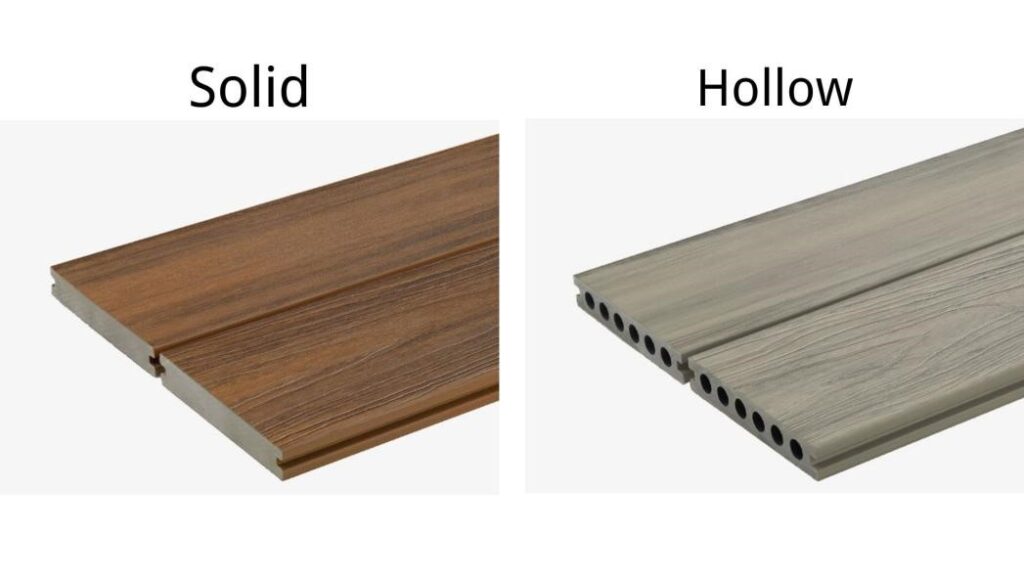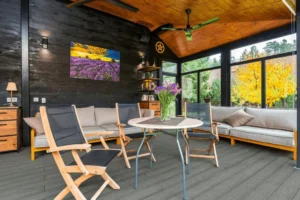Solid Decking vs Hollow Decking: Which Is Better?
Outdoor decking serves as an extension of living spaces, providing areas for relaxation, entertainment, and aesthetic enhancement. Wood plastic composite (WPC) decking has become a popular alternative to traditional wood decking materials in recent years. And it generally has two types: solid composite decking and hollow composite decking.
Understanding Solid Composite Decking and Hollow Composite Decking
Solid and hollow decking represent two distinct categories of decking materials. Each type comes with its own set of characteristics, advantages, and drawbacks. Understanding the nuances between solid and hollow decking is essential for making informed decisions about which option best suits your needs. Exploring the differences between solid and hollow decking can help homeowners and builders make informed choices when planning outdoor projects.
Solid composite decking comprises uniform, solid boards that possess consistent thickness throughout their structure. These boards offer substantial weight and density, providing a sturdy and stable platform for outdoor living areas.
In contrast, hollow composite decking features a hollow core design, resulting in lighter-weight boards with hollow chambers inside. These chambers reduce material usage and weight, making hollow decking a more economical option in some cases.

Characteristics of Solid Composite Decking
Solid composite decking boards are prized for their robustness and durability. Their solid construction provides enhanced strength, stability, and resistance to impact and heavy loads. Solid boards offer superior thermal stability, making them less prone to expansion and contraction due to temperature fluctuations. Additionally, solid decking tends to exhibit minimal flexing or sagging over time, maintaining a level surface even under heavy foot traffic.

Pros of Solid composite decking:
– Exceptional strength and stability
– Reduced noise and vibration
– Enhanced resistance to impact and heavy loads
– Superior thermal stability
– Minimal flexing or sagging
Cons of Solid composite decking:
– Higher material cost
– Heavier weight may require additional support during installation
– Susceptible to moisture accumulation if proper drainage is not ensured
Characteristics of Hollow Composite Decking
Hollow composite decking boards feature a lightweight design that makes them easier to handle and install compared to solid boards. The hollow core construction reduces material usage and weight without compromising structural integrity. Hollow decking offers excellent resistance to moisture, as water can drain freely through the hollow chambers, preventing pooling and potential damage. However, hollow boards may be more prone to flexing and sagging under heavy loads, requiring additional support for optimal performance.

Pros of Hollow composite decking:
– Lightweight and easy to handle
– Cost-effective option due to reduced material usage
– Excellent resistance to moisture and mold growth
– Enhanced ventilation and drainage properties
– Environmentally friendly design with reduced material consumption
Cons of Hollow composite decking:
– Reduced structural strength compared to solid decking
– Greater potential for flexing and sagging, especially under heavy loads
– Limited availability of color options and finishes
Solid Decking vs Hollow Decking: Which is better?
After learning about the characteristics of both solid and hollow board, you may wonder which is better. Actually, they are different advantages which means you can choose according to your needs. Solid composite decking is constructed from solid pieces of composite material throughout its entire thickness. This results in a dense and sturdy decking board that offers exceptional strength and durability. Solid decking boards are less prone to flexing and sagging, making them ideal for high-traffic areas and heavy loads. They also provide a more solid underfoot feel compared to hollow decking.
On the other hand, hollow composite decking features a hollow core that reduces the overall weight of the board without compromising its strength and durability. Hollow decking boards are lighter and easier to handle during installation, making them a preferred choice for DIY enthusiasts and projects with accessibility challenges. Additionally, the hollow design allows for better airflow and drainage, which can help prevent moisture buildup and mold growth.
When comparing solid and hollow composite decking, there are several factors to consider. Solid decking tends to be more expensive upfront due to its denser construction and higher material costs. However, it offers superior longevity and performance, requiring minimal maintenance over its lifespan. In contrast, hollow decking may require additional support and reinforcement to prevent flexing and bending, especially over long spans or under heavy loads.
Ultimately, the choice between solid and hollow composite decking depends on individual preferences, budget constraints, and project requirements. Solid decking is ideal for areas where durability and longevity are paramount, such as high-traffic commercial spaces or waterfront properties. Meanwhile, hollow decking may be a practical option for residential decks, balconies, and rooftops where ease of installation and weight considerations are important factors.
Conclusion
In conclusion, when it comes to choosing between hollow and solid composite decking, it’s essential to weigh the pros and cons of each option based on your specific needs and preferences. Solid decking offers unmatched strength and stability, making it suitable for high-traffic areas and projects prioritizing durability. Conversely, hollow decking provides a lightweight and cost-effective alternative, excelling in moisture resistance and ease of installation. Ultimately, the decision hinges on factors such as project requirements, budget considerations, and personal preferences. By carefully evaluating these factors,
Trending Reading
What Are the Differences Between the WPC Board and PVC Board?
[2024 Update] How Long Does WPC Decking Last?













